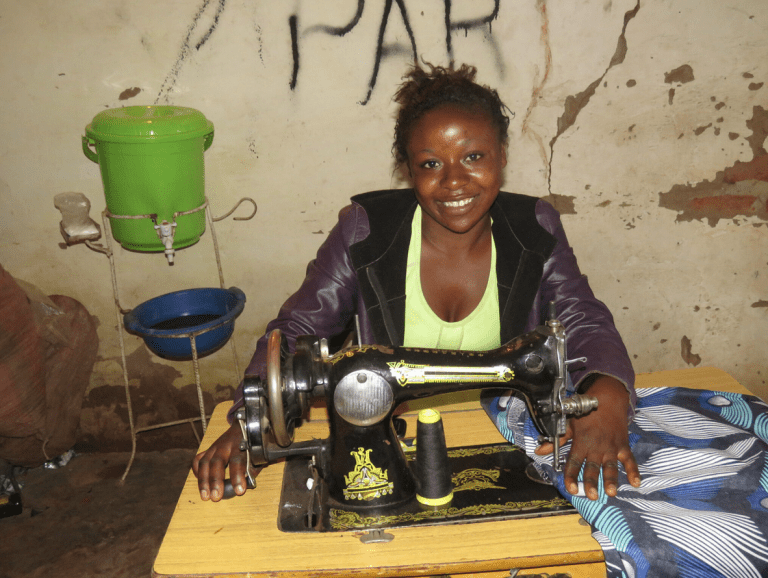Blog
Pact’s Vocational Education Programme

This article was originally published here on United Nations University’s knowledge platform on modern slavery, human trafficking, forced labour and child labour. The views expressed herein are those of the author(s) and do not necessarily reflect the views of the United Nations University. The views expressed here are the sole responsibility of the author and they do not reflect the official views of the ILO.
Since 2015, Pact has worked in the Democratic Republic of Congo to eliminate and address child labour in Artisanal Small-scale Mining (ASM), which is one of the worst forms of child labour. We use a multisectoral approach in collaboration with communities, administrative authorities, companies and child miners themselves. In this approach, we have facilitated the retrieval of 705 adolescent miners (15-18 years old) from mine sites in the DRC, providing them with vocational trainings in alternative trades.
The DRC is endowed with some of the largest mineral deposits in the world. The country produces about 60 per cent of the world’s cobalt and about 4 per cent of cassiterite. It is estimated that at least 20 per cent of cobalt and 8 per cent of cassiterite are produced by artisanal miners through manual labour and the use of rudimentary tools.
Our vocational education programme seeks to equip adolescent miners with skills and knowledge to prosper in a safe and economically viable trade. It uses a hybrid approach that incorporates the valuable technical supervision of local vocational education institutions while utilizing a hands-on, 6-month curriculum designed by local tradespeople and professionals. The roll-out of the vocational education programme follows a series of phases, as shown in Figure 1.

From adolescent miners to apprentices
Since 2017, Pact has enrolled 705 adolescent miners living in 16 ASM communities producing cassiterite and cobalt in its apprenticeship programme across 12 different trades. Out of those, 145 adolescents are currently being trained. They will graduate before the end of 2021.
Overall, 97 per cent of adolescent miners (589 total, including 332 girls and 257 boys) who finished the training graduated from the programme. Out of those who graduated, 96 per cent have left the mine and have not returned. In 2020, over 95 per cent of former apprentices are working either independently, with their mentors or are otherwise employed. They earn between 50,000 Congolese Francs (equivalent to USD 25) and 500,000 Congolese Francs (equivalent to USD 250) per month. Their average income is equivalent to, and sometimes even higher than, the average income in the community.

Additionally, 98 per cent of them earn more than when they were working in the mines. Former apprentices save an average of USD 20-25 per month in various ways, including through Pact’s WORTH programme, placing money in a safe at home or using mobile money. These savings are used to develop a side business, reinvest for growth in their trade or to pay for their younger siblings’ school fees, among other things. 91 per cent of former apprentices state that their income is sufficient and 65 per cent are of the opinion that their income is more stable than when they worked in the mine. Additionally, many former apprentices have gone back to school part time and are financing their own education costs, as well as that of their siblings. Overall, graduated apprentices generate revenue, save and even support their families.
Why is the project so successful?
Market studies on the most promising trades
Each year, Pact leads a market study to identify light, non-hazardous apprenticeship opportunities in each of the project communities. These studies have served as excellent tools to facilitate the adolescent miners’ placement, based on data collected on the economic viability of alternative trades to mining in project communities. The studies generate data from children working in the mines and independent artisans living in the project communities. Identified trades include: tailoring, beauty and hairdressing, IT/computers, auto mechanic, moto mechanic, carpentry, small trades and business, welding, construction and masonry, household electronics, agriculture and animal rearing as well as baking.
Skill and capacity building with innovations
The apprenticeship provides six months of training. This training has continued to be developed as more needs have presented themselves. During the first years of implementation, Pact noticed that a large percentage of apprentices could not read or write. Their lack of basic literacy and arithmetic skills were putting them at a further disadvantage in securing success as entrepreneurs in their various new trades. Pact therefore trialed and introduced a literacy programme. While apprentices originally found it difficult, they saw that it improved their understanding of the trade and their level of reading and writing. Since then, Pact has increased the literacy component of the apprenticeship.
Another addition was including several workshops for the apprentices to ensure they have the minimum life skills necessary to secure employment, thrive in the workplace or launch and maintain a small business. For example, workshop themes include: professional skills, sexual and reproductive health, sexual abuse and sex trafficking, as well as entrepreneurship, financial literacy, and management of micro-enterprises. These supplementary workshops help augment their choices after graduation as they allow these youth to create the life they want outside of the mines.
A Continuum of support with youth agency
To ensure that apprentices do not continue working in the mines during their apprenticeship, Pact provides a continuum of support starting from selection and continuing beyond graduation. First, the children choose their own trade and Pact provides a small stipend to replace income from the mine and to cover food and ancillary items. Thanks to this measure, 98% of apprentices do not work in the mines during their apprenticeship.
“At the beginning of the programme, children received no bonus and did not eat anything since the morning. However, when they started receiving teaching materials, a small monthly amount and a sandwich at noon, the rate of absenteeism and drop-out decreased.”
— A trade mentor